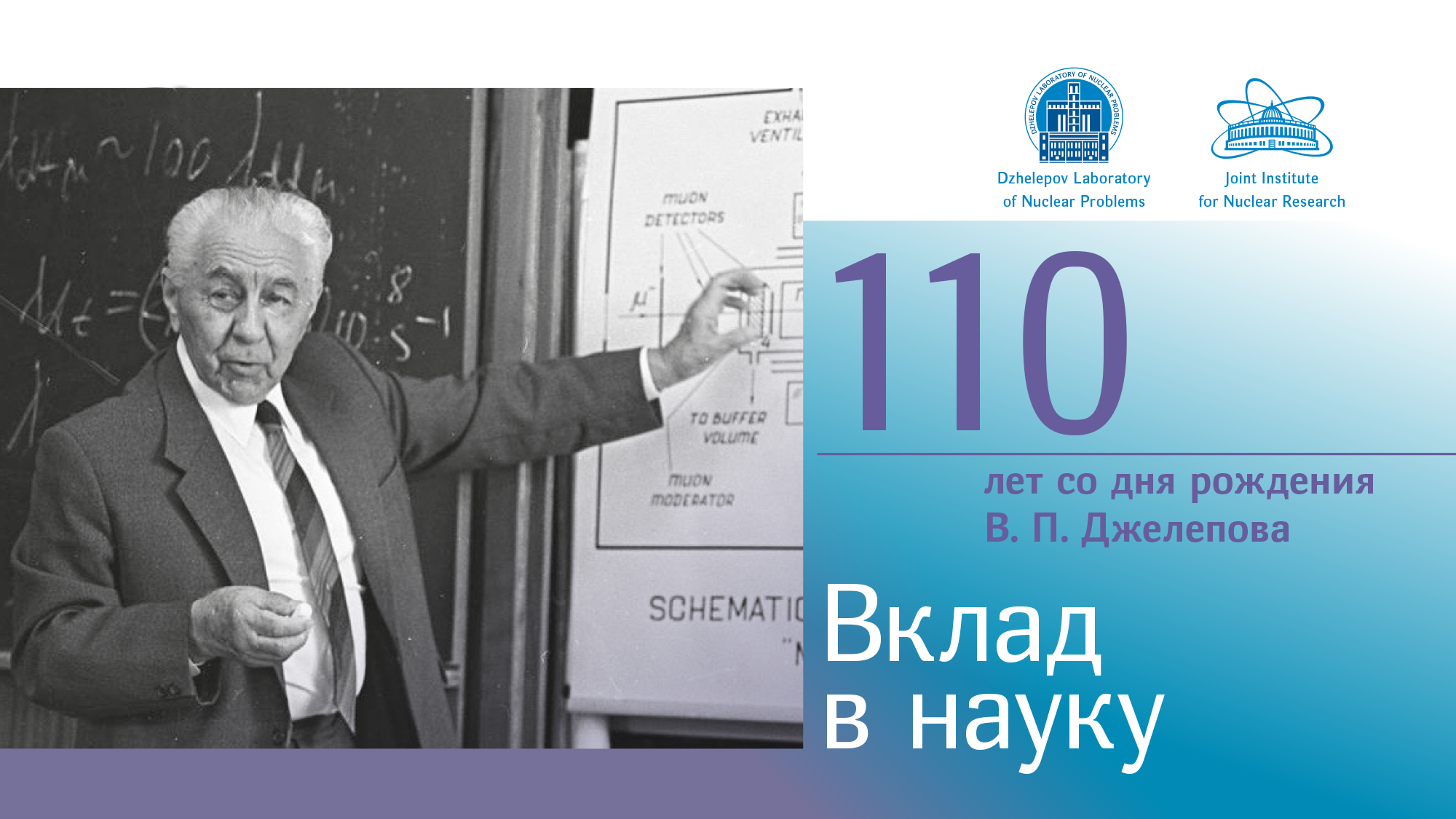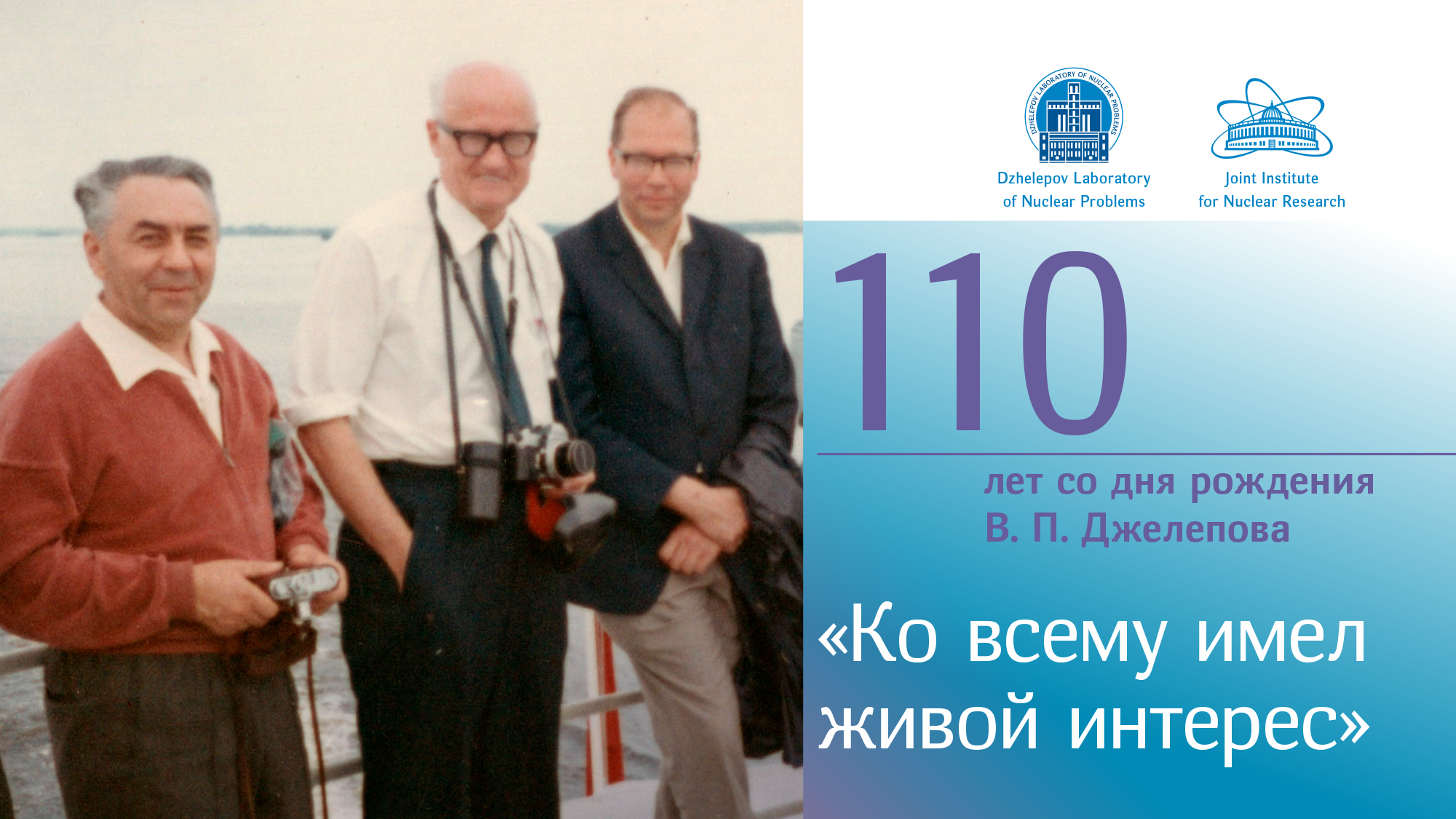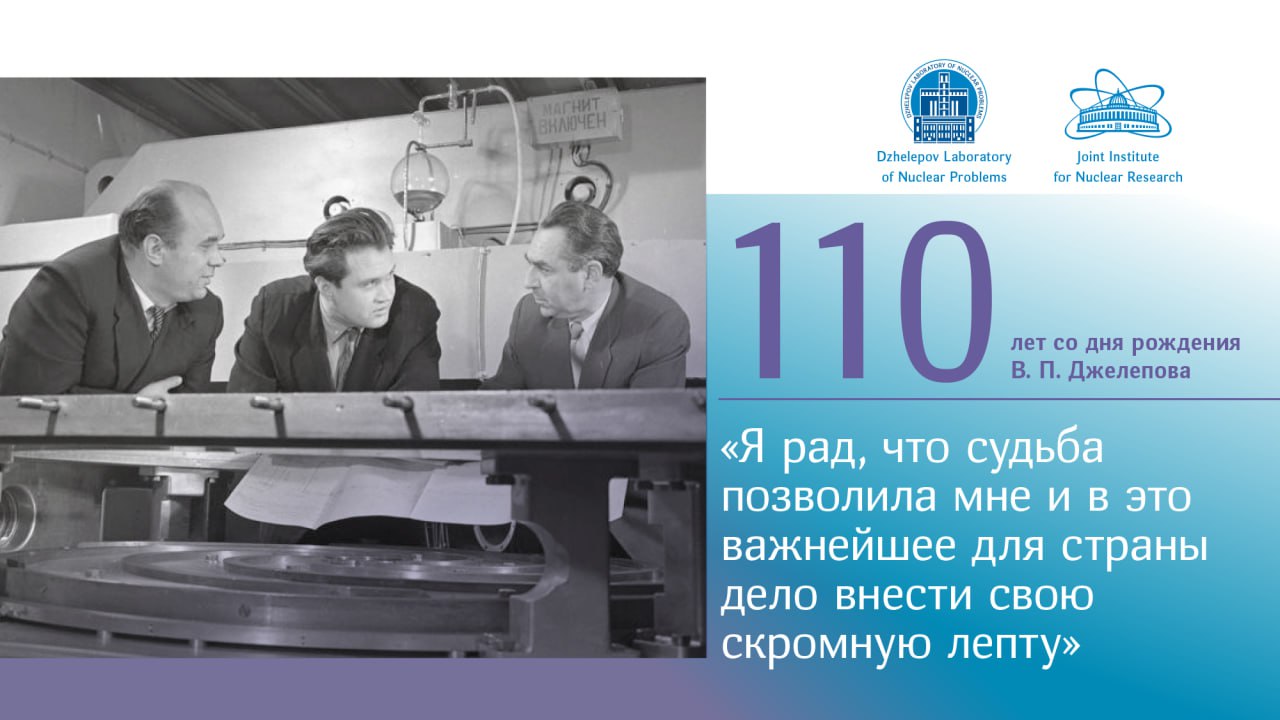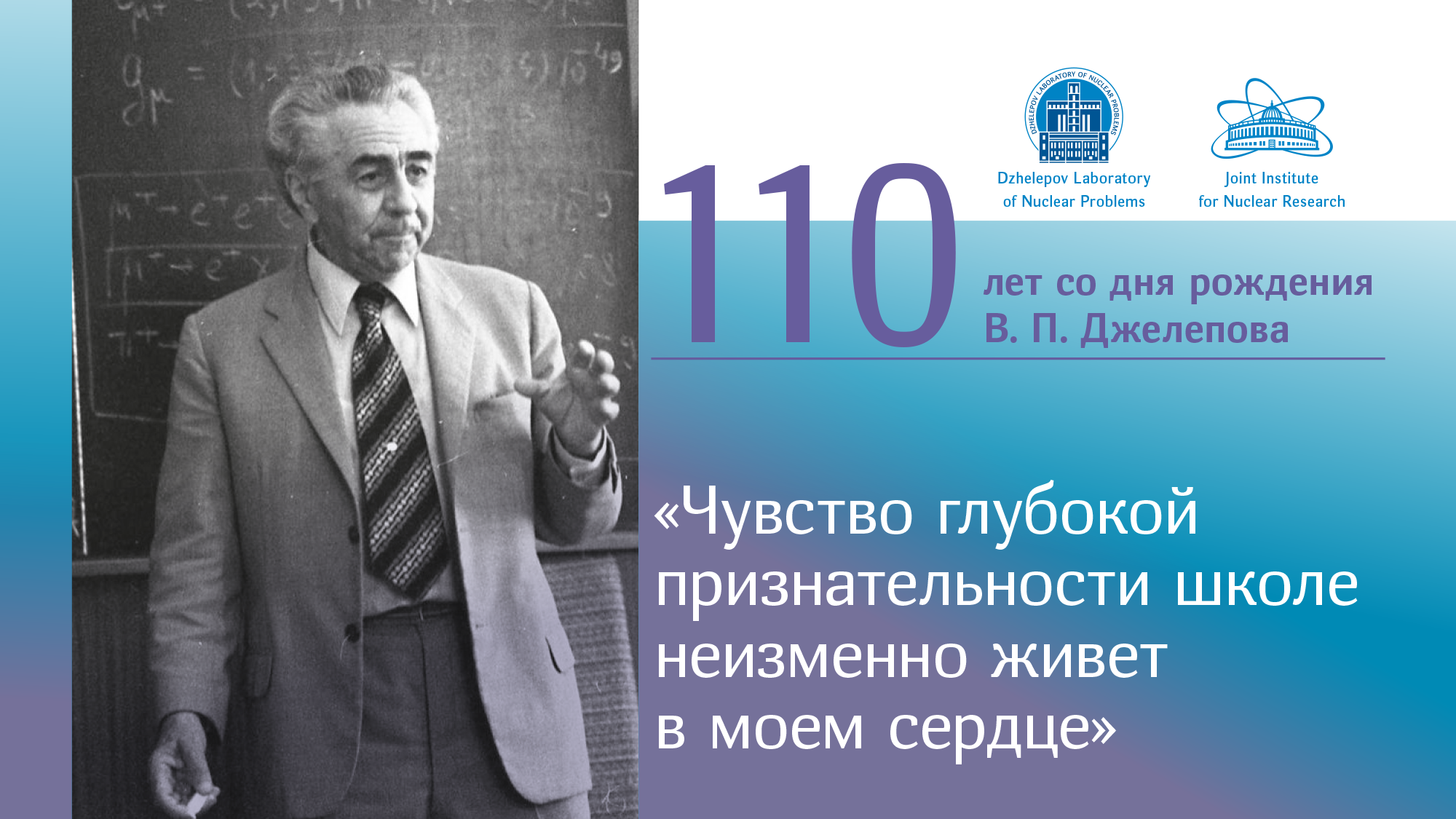Commemorating the 110th Birthday of V. P. Dzhelepov. His Contribution to Science

For your reference:
“A large personal contribution to elementary particle physics, accelerator physics and technology made Venedikt Petrovich famous worldwide. His pioneering studies of elastic and inelastic nucleon−nucleon and pion−nucleon interactions at an energy of hundreds of MeV are widely known, as also is determination of important properties of symmetry of strong interactions at these energies. The experimental investigations of nucleon−nucleon interactions conducted as far back as 1950s became the classics. They were widely quoted in research literature, monographs and textbooks remaining among the best in the precision of results. In a series of studies of pion production processes during collisions of neutrons with protons and nuclei conducted by V. P. Dzhelepov in the 1950s−early 1960s, the validity of the fundamental property of symmetry of nuclear forces, their isotopic invariance, was proved.
Studies of mu-atomic and mu-molecular processes in hydrogen, a discovery of a unique phenomenon of resonance dependence of the muonic molecules dtµ and ddµ and the first experimental observation of a high-probability muonic catalysis of the deuteron and triton fusion reaction are the core part of the scientific legacy of V. P. Dzhelepov.
This experimental and theoretical work of scientists from Dubna drew a large response in the scientific community resulting in the intense muonic catalysis research in the USA, Great Britain, Japan, Switzerland, Italy, Austria, in convening international conferences and in publishing a specialized journal, “Muonic Catalysis”. Muonic catalysis turned out to be a novel promising direction in nuclear physics. In 1986, V. P. Dzhelepov was awarded the Kurchatov Gold Medal and the Prize of the Academy of Sciences of the USSR for a series of studies on mu-catalysis and mu-molecular processes in hydrogen isotopes. His research results are of great value for verifying predictions of the theory and its further development and serve as a basis for potential use of muonic catalysis in developing new energy sources.
Dzhelepov’s contribution to the development of the accelerator basis for physics research was also immense. In 1959, the world’s first isochronous cyclotron with a spiral variation of the magnetic field was commissioned at the Laboratory of Nuclear Problems. The beam dynamics studies performed at it became the basis for high-current phasotron development. A new JINR basic facility, a high-current proton phasotron with an energy of 680 MeV with a spiral structure of the magnetic field, was constructed at the Laboratory of Nuclear Problems due to the initiative of V. P. Dzhelepov and under his guidance. The implementation of the project allowed a twentyfold increase in the intensity of the proton beam and meson beams from the external target. The accelerator has been successfully used in experiments already for 27 years.
V. P. Dzhelepov was one of the first who considered the possibility of using high-current isochronous cyclotrons for monitoring subcritical assemblies and designing on this basis safe nuclear power engineering and facilities for transmutation of nuclear waste.
V. P. Dzhelepov was the first who had employed high-energy protons and other charged particles for tumour therapy. It was he who developed for the first time proton and neutron beams with energies of several hundreds of MeV for biophysical and radiobiological research in space medicine.
In addition to this large-scale research, a number of significant experimental investigations of fundamental problems of electroweak interactions, multiple production of neutral and strange particles in pr interactions at an energy of 5 GeV, hypercharge-exchange processes in kaon−proton interactions were conducted by Venedikt Petrovich.
In 1966, V. P. Dzhelepov was elected a corresponding member of the Academy of Sciences of the USSR (AS of the USSR). He brought up a large number of scientists whose research was widely known to the international scientific community. Many physicists and engineers, among which were tens of doctors of science and above 50 candidates of science, were supervised by V. P. Dzhelepov.
Fundamental studies performed at the synchrocyclotron and the phasotron constructed on its basis by physicists from many institutions of higher education of the Soviet Union, Russia and research centres of other JINR Member States brought to the Laboratory a wide international notice and appreciation. Thirteen scientific discoveries recorded in the State Register of the Soviet Union were made by scientists of the Laboratory. One hundred doctors of science and 250 candidates of science were prepared at LNP. Nowadays, many of the laboratory ex-scientists are heading large scientific teams at different institutions and laboratories of Russia and other JINR Member States.
Of great wideness was administrating and public activity of V. P. Dzhelepov. Since 1967, he had been acting as a deputy academician secretary of the Department of Nuclear Physics of the AS of the USSR (now RAS). He spent a lot of energy for strengthening and developing the international cooperation of scientists from the RAS and the Joint Institute for Nuclear Research. Venedikt Petrovich headed scientific delegations of the USSR and JINR at large international physics forums many times. In 1967−1972, he represented the USSR at the International Committee on Particles and Fields of IUPAP. In 1977−1982, V. P. Dzhelepov was a member (on behalf of the USSR) of the International Committee on Future Accelerators (ICFA) of IUPAP.
Over 25 years, Venedikt Petrovich was part of the editorial board of the “Journal of Experimental and Theoretical Physics”. In 1970−1988, he was a member of the editorial board of the international journal “Particle Accelerators”. In 1987−1993, he was a member of the editorial board of the journal “Muon Catalysed Fusion”. Since 1970, he had been a member of the editorial board of the journal “Physics of Elementary Particles and Atomic Nuclei”. In 1962−1970, he was a chair of the Expert Committee of the Higher Attestation Commission of the USSR in physics and astronomy. He spent a lot of his time engaged in the Intergovernmental Soviet-Danish Commission on scientific and economic cooperation (1970−1986).
The scientific and science administrating activity of V. P. Dzhelepov was widely appreciated. In 1951, he was awarded the Order of Lenin and the State (Stalin) Prize of the USSR for constructing and launching the synchrocyclotron. In 1953, he was awarded the State Prize of the USSR again, this time for the large series of investigations at this accelerator. V. P. Dzhelepov was awarded two Orders of Red Banner of Labour (in 1969 and 1974), the Order of October Revolution (1983) and the Order of Friendship (1996). He was awarded the Order of Cyril and Methodius I class of the People’s Republic of Bulgaria, the Order “Golden Polar Star” of the Mongolian People’s Republic, the Order of the Red Banner of Labour of the Hungarian People’s Republic and other orders and medals of the JINR Member States.”
(Based on the materials from http://jinrmag.jinr.ru/win/2013/15/vp15.htm).





